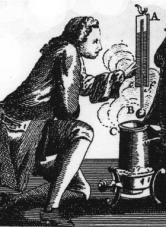Mercury-in-glass thermometer facts for kids
The mercury-in-glass thermometer is a tool used to measure temperature. It was invented by Daniel Gabriel Fahrenheit in Amsterdam in 1714. This thermometer has a small glass bulb filled with mercury, which is connected to a very thin glass tube.
When the temperature changes, the mercury in the bulb expands or shrinks. This small change in volume makes the mercury level move up or down the narrow tube. The space above the mercury in the tube might be empty (a vacuum) or filled with a gas like nitrogen.
Mercury thermometers cannot measure very cold temperatures, because mercury freezes at -39°C. They also cannot measure very hot temperatures, as mercury boils at 356.7°C. Today, many thermometers use alcohol instead of mercury. Alcohol is often cheaper and safer to use.
Contents
A Look Back: History of Thermometers

The mercury thermometer was important for creating the temperature scales we use today, like the Fahrenheit and Celsius scales.
Anders Celsius and His Scale
Anders Celsius, a scientist from Sweden, created the Celsius temperature scale. He wrote about it in 1742. Celsius used two main points for his scale: the temperature where ice melts and the temperature where water boils.
This idea wasn't completely new; Isaac Newton had worked on something similar. But Celsius focused on the melting point of ice, not the freezing point. He did many experiments over two winters to make sure his thermometer was accurate. He found that ice always melted at the same mark on his thermometer.
He also found a steady point for boiling water. Celsius noticed that the boiling point could change a little with air pressure. When he took the thermometer out of the steam, the mercury level would go up slightly. This happened because the glass cooled down and shrank quickly.
How Celsius Defined His Scale
When Celsius first made his scale, it was "upside-down." He set the boiling point of pure water at 0°C and the freezing point at -100°C. But just one year later, a French scientist named Jean-Pierre Christin suggested flipping the scale. He proposed that the freezing point should be 0°C and the boiling point 100°C. He called this scale "Centigrade," meaning "100 grades."
Celsius then suggested a way to set up a thermometer:
- First, put the thermometer in melting ice made from pure water. Mark where the mercury stops. This is the freezing/melting point of water.
- Next, put the thermometer in boiling water vapor. Mark where the mercury stops again.
- Finally, divide the space between these two marks into 100 equal parts.
These methods are good for a general setup. However, both points can change slightly with air pressure. Nowadays, scientists use the "triple point" of water for very precise measurements. This is a specific temperature and pressure where water can exist as a solid, liquid, and gas all at once. It happens at 0.01°C.
Before we understood true thermodynamic temperature, the thermometer itself "defined" the temperature. Different types of thermometers (like alcohol or mercury) might give slightly different readings. But in practice, many materials gave very similar temperatures, and these were close to the true thermodynamic temperature when it was discovered.
Images for kids
See also
 In Spanish: Termómetro de mercurio para niños
In Spanish: Termómetro de mercurio para niños





